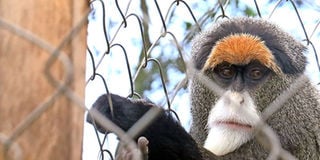OUT&ABOUT: Park that oozes natural beauty

Rare deBrazza monkey in cage at the Kitale Nature Conservancy. PHOTO| MAYA MANGAT
What you need to know:
- Driving through the facade cum driveway, we encounter animal statues.
- A few metres away to the nature trail, there’s a colourful scene from biblical times.
- Before we get to the holy mountains, our ancestors — Australopithecus and Homo Sapiens — are lined to show human evolution in over millions of years.
- It calls for more photo shoots with the life-size ancestors.
It’s been an exciting night camping at Saiwa Swamp National Park sandwiched between Mount Elgon and Cherangani Hills. After a filling breakfast at a roadside kiosk near the park, we’re off to Mount Elgon, Africa’s eighth highest peak. A sign near Kitale perks our interest — it’s Kitale Nature Conservancy.
Driving through the facade cum driveway, we encounter animal statues, a pot-bellied policeman with a tire sandal and a shoe on each foot at the entrance, and a land rover with a seemingly drunk driver. The statues are really satirical, and I begin wondering whether we’re in an art gallery or a nature conservancy.
The receptionist assures us that we’re in a nature conservancy. An arrow points to the nature walk that’s a few kilometres long through a woodland and a five-acre wetland. A few metres away to the nature trail, there’s a colourful scene from biblical times.
Before we get to the holy mountains, our ancestors — Australopithecus and Homo Sapiens — are lined to show human evolution in over millions of years. It calls for more photo shoots with the life-size ancestors. A side step and the botanical garden is full of trees — many indigenous and some exotic — 800 species according to the list.
And then there’s a burst of colour and figures from the biblical times — Jesus and the saints, the story of the nailing and a lot more. I’m dazzled.
On the nature trail, it’s really peaceful with an earth-coloured stream meandering it. There’s a quiet patch under the trees perfect for meditation, and signs point to a boat for a sail on the river. But the boat is nowhere to be seen. Instead, a sign on a tree reads ‘mind your fourhead’. There are few more of these misspelt signs but they add humour along the trail, including the one for ‘leg speed at 2km per hour’. The forest opens to the wetland over several rickety bridges.

The conservancy’s Ankole cows in the wetland. PHOTO| MAYA MANGAT
ADVENTURE
The wetland is for the rare marsh antelope — the sitatunga. A gorgeous jewelled flycatcher, herons and a pair of the stately Grey crowned cranes enjoy the swamp. The Grey-crowned crane population has crashed by 80 per cent in the last two decades on the continent.
And then along the narrow path, a herd of Ankole cattle with enormous horns browse. They are just too close for comfort. The herd, we are told by a guide, are a gift from President Yoweri Museveni across the border in Uganda.
The dangerous-looking horned cows aren’t bothered by us and they continue grazing. It takes a while for them to move off the path and we make a dash past them. At the end of the trail that opens to a huge grass field, we find children patting the ‘dangerous’ looking Ankole cows.
Across the field are the cages for animals, either rescued or deformed. The pair of lions — female and male strut the wire cage as does the neighbouring spotted hyena. The rare deBrazza monkey — a denizen of the old indigenous forest — is at a loss where to rest because the forked tree trunk has no place for it to lie. The Grey crowned cranes are so pretty and we pose for pictures by their cage. The Maasai ostriches are terribly bored biting on the wire fence.
Two hours later, we’re back to our starting point and looking up at the roof is a huge cooking pot. The characters standing by it are happy not to be cooking inside the pot. It’s a busy place as many families enjoy a day out.
It’s also heart-warming to see the effort of the person who has established the conservancy raise awareness about the natural world. Scrolling through the website, Mr Boniface Ndure, a retired primary schoolteacher, has a vision to turn the conservancy into a leading place for the environment and biodiversity.
The only change l would recommend is that the animal cages need to be better designed. Otherwise, there is a lot of fun, humour and information in the conservancy.




